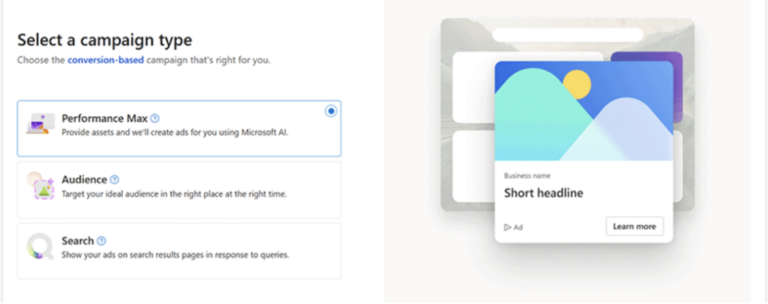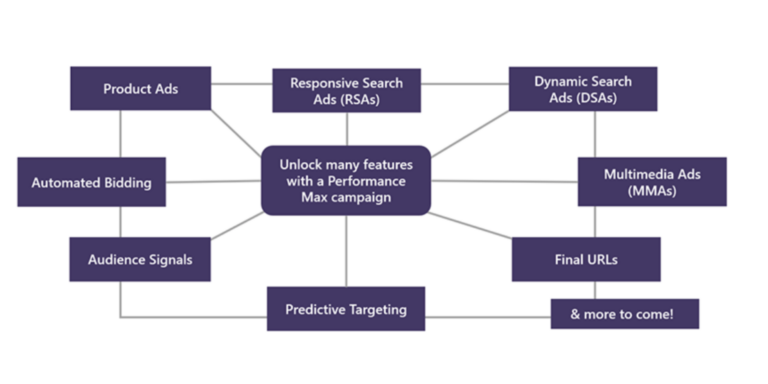
Performance Max on Microsoft vs Google – how you can allocate your budget over to Microsoft.
There are two heavyweights in the advertising space: Microsoft Advertising and Google Ads, both offering Performance Max (PMAX) solutions.
Google dominates the market, with many advertisers overlooking Microsoft’s capabilities. As Microsoft Advertising’s biggest global channel partner, we’ll explore how incorporating Performance Max Campaigns into your paid strategy can benefit yourself or your clients.
Advertisers often neglect advertising on Microsoft, but diversifying your strategy to include it can be advantageous. This discussion is timely, as Microsoft Advertising’s PMAX campaigns have recently become available globally.
Let’s examine both Google and Microsoft’s Performance Max solutions and how you can easily allocate some of your budget from Google to Microsoft this year.
What is Google Performance Max?
Performance Max has taken center stage for Google since its release in 2021. This campaign type automates placements across Google’s channels, including YouTube, display, search, discover, and more. Using Google’s machine learning, it optimizes ads based on set objectives, creating ads automatically from advertisers’ inputs, similar to responsive and display ads.
Here are some benefits of running a Google Ads performance max campaign.
- Cross-platform reach: This is the only campaign type that allows you to reach the entire Google ecosystem in one campaign, opening up additional audiences not reachable with singular campaign types.
- Simplified campaign management: PMAX provides unified reporting across all platforms, reduces manual work like bid adjustments, and is simple to set up.
- Automated bidding: Google handles optimizing bids for the right user at the right time with the right message, and it optimizes the budget across different placements based on performance.
- Advanced creative capabilities: You can leverage a wide variety of ad formats, as ads can be placed across the entire Google ecosystem. Google also automatically tests different formats and combinations for peak effectiveness.
- Adaptiveness: The machine learning capabilities of PMAX mean that algorithms quickly adapt to sudden user behavior changes, market trends, or seasonality.
But how do you know if a Google Performance Max campaign is right for your business?
Consider if your service relies on:
- How quickly sales are generated
- Budget flexibility
- Sufficient creative assets
PMAX campaigns work particularly well for e-commerce advertisers, especially if product feeds are enabled within the campaign. If you’re already using PMAX on Google, this article will now focus on Microsoft PMAX campaigns and how you can easily shift some of your budget from Google to test advertising on Microsoft.
Performance Max Campaigns on Microsoft
Advertisers of today are always looking for new ways to deliver more results with less effort. Recently, Microsoft Advertising announced that their PMAX campaigns are now available globally, which is great news for advertisers around the world to try out this campaign type.

Performance Max is an automated campaign type that leverages best-in-class AI for campaign management. Advertisers set the strategy with goals, assets, and signals, while the AI dynamically creates and optimizes ads across Microsoft Advertising surfaces, delivering better results in a hassle-free campaign.
This all-in-one campaign offers streamlined setup for multi-format, cross-channel optimization and, driving more conversions with AI-powered recommendations to reach your goals.
Case studies from the open beta of Performance Max have shown great performance, delivering more conversions at efficient costs.

Things you should keep in mind when first setting up Performance Max via Microsoft Advertising
If you want to import your PMAX campaigns from Google Ads or set up your own Microsoft campaign, follow these three steps:
- Define your goals: PMAX optimizes based on the types of conversions most valuable to your business.
- Create creative assets: Provide as many high-quality text and image assets as possible to deliver relevant ads to your customers. Microsoft’s AI will generate new asset recommendations based on your inputs and final URL, allowing for more ad formats.
- Create audience signals: Indicate which types of customers are most valuable and likely to convert. The campaign will then optimize for these users across the Microsoft Network. Although not required, audience signals can accelerate the learning and optimization phase of your PMAX campaign.
Features of Microsoft Performance Max:
- AI Management: PMAX campaigns use Microsoft’s cutting-edge AI for hassle-free management, assisting with asset creation and audience identification.
- Automated Conversion Optimization: Define your campaign strategy, including goals, assets, and signals. The AI dynamically generates and optimizes ads across surfaces like Bing, AOL, Yahoo, and Outlook to maximize performance.
- Streamlined Setup: PMAX simplifies campaign setup with a unified platform for various ad types, including text and image formats.
- Asset-Focused Approach: Input your assets into designated groups, and PMAX optimizes them to reach audiences at the right time.
- AI-Powered Recommendations: PMAX provides personalized recommendations tailored to your goals, adapting to your needs and fine-tuning your campaign for optimal performance
A note on Google Import for Smart Shopping and Dynamic Search Ad (DSA) Campaigns – If you’ve imported a Performance Max campaign from Google Ads that originated as a Smart Shopping or DSA campaign, Microsoft will upgrade it to a Performance Max campaign in phases over the next few weeks.
If you are using a third-party platform that doesn’t support Performance Max yet, your campaigns will continue to be imported as Smart Shopping or DSA.
Performance and Optimization Differences
Performance is the core of any campaign, and both Google and Microsoft use machine learning to enhance it.
Google’s extensive ecosystem offers consistent and scalable results, with machine learning models trained on diverse data points for precise targeting and placements.
Microsoft Advertising stands out with its LinkedIn integration and predictive analytics, keeping it ahead of the curve by anticipating user behavior.
Cost Differences
When advertisers are asked about their ultimate metric, return on investment (ROI) tops the list. While neither platform has fixed pricing models, distinct cost patterns are evident.
Costs between Google ads vs Microsoft ads vary based on targeting options, audience reach, platform competition, and bidding strategies. Generally, Google PMAX campaigns may be more expensive due to its larger user base and broader reach across Google Search, Display Network, and YouTube. Conversely, Microsoft PMAX campaigns can be more cost-effective, especially for niche markets or industries with lower competition. Ad relevance and quality score also impact costs on both platforms.
Advertisers should analyse their campaign goals, target audience, and budget to determine the most cost-efficient platform for their needs.
What’s coming in the future with Performance Max?
Throughout the year, Microsoft Advertising will add more capabilities to their Performance Max campaigns, including brand exclusions, search insight reports, search themes, and video assets. Microsoft is continuously investing in PMAX, making it increasingly powerful.
If you’re a marketing agency wanting to advertise on Microsoft, head to our website to find out more about our Diginius Agency Partner Program. Meanwhile, if you are a business managing your paid advertising in-house and you would like our support, discover how our Diginius Insight Platform boosts your ROI.



